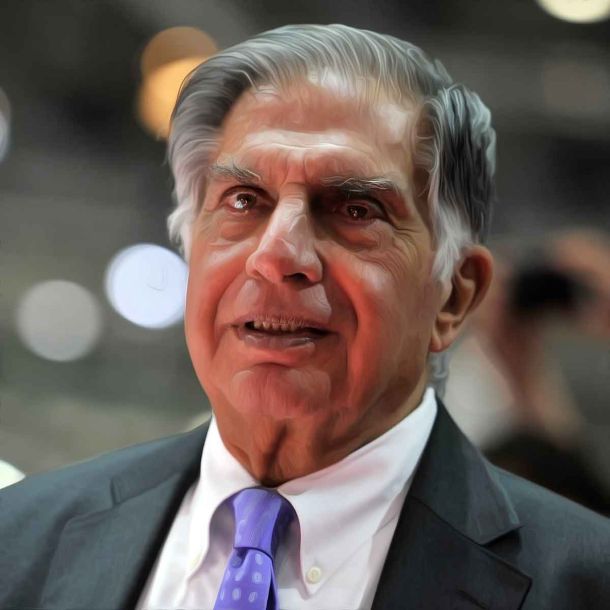More Coverage
Twitter Coverage
Satyaagrah
Written on
Satyaagrah
Written on
Satyaagrah
Written on
Satyaagrah
Written on
Satyaagrah
Written on
Join Satyaagrah Social Media
Chronicles of Valour- The Battle of Haldighati

There was a big controversy regarding the outcome of the Battle of Haldighati as to who was the winner and the consequences thereof. This controversy was triggered by the decision of the Rajasthan Education board to revisit the theory that Akbar won the battle easily. Actually, various facts point contrary to this theory which has been spoon fed by history text books. Before trying to look into the details of the aforesaid great battle, let’s explore some facts which led to this bloody encounter or I should say series of bloody encounters.
As most of us know, Akbar was the Mughal emperor during that time. He had subjugated most of the kingdoms in Rajputana and had active military support of some of the biggest and powerful kingdoms of that time. Primary among these was the Kachchwaha state of Amber, currently known as Jaipur. Amber armies were usually at the forefront of Mughal armies and often acted as vanguard. It should also be mentioned here that whatever this bonhomie suggests, truth was that Mughals never fully trusted the Rajputs.
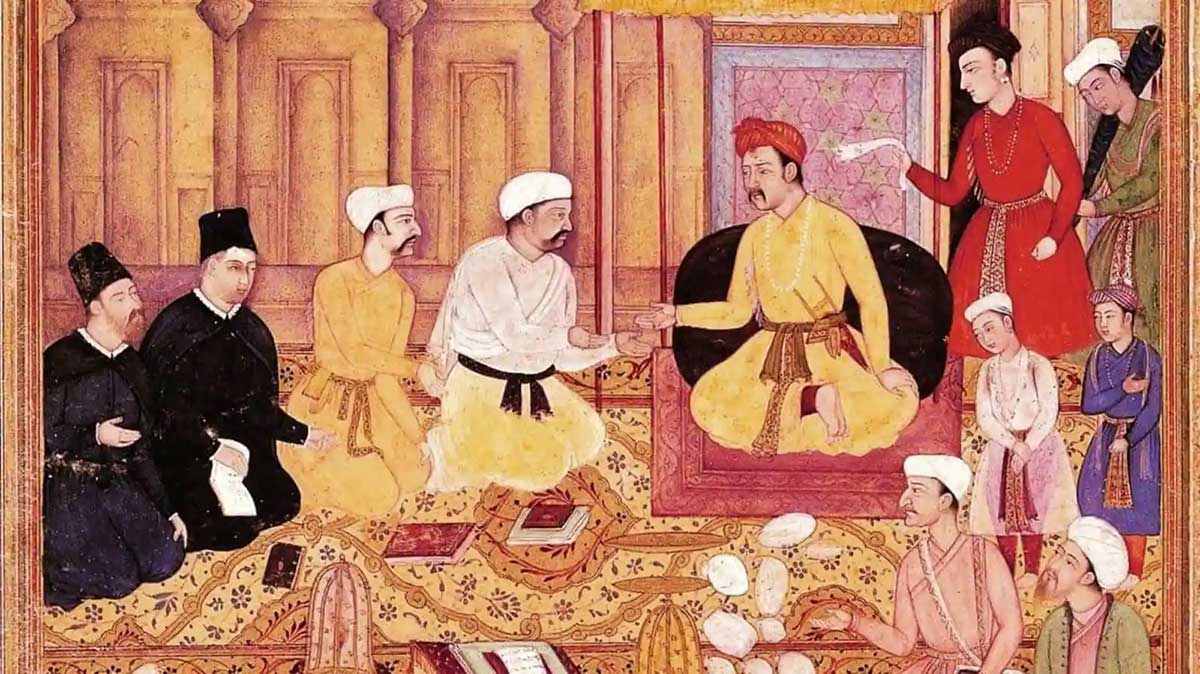 |
Man Singh, the crown prince of Kachchwaha clan considered himself as the primary leader of the Rajputs. He was also a distinguished commander of the Mughal army. The Sisodias of Mewar made mockery of this. Sisodia clan was led by Maharana Pratap Singh of Mewar, who was the grandson of famous warrior Maharana Sangram Singh or Rana Sanga as he was called. Sisodias had a long history of conflicts with Mughals and had already fought many wars with them. Akbar considered Maharana Pratap and kingdom of Mewar a thorn in his side. He wanted complete subjugation of Rajputs but this was not possible till the Sun flag of Mewar fluttered high. Akbar made diplomatic advances first by sending emissaries to Mewar, but without much success.
Akbar decided to use Rajputs against Rajputs and sent Man Singh as his emissary to Mewar. He wanted Rana Pratap to acknowledge him as the emperor and also wanted him to be his vassal, just like Man Singh. Maharana Pratap did not pay heed to any of the logics and schemes put forward by Man Singh and declared his independence. The mission failed; then something happened which brought war to the gates of Mewar even earlier than predicted.
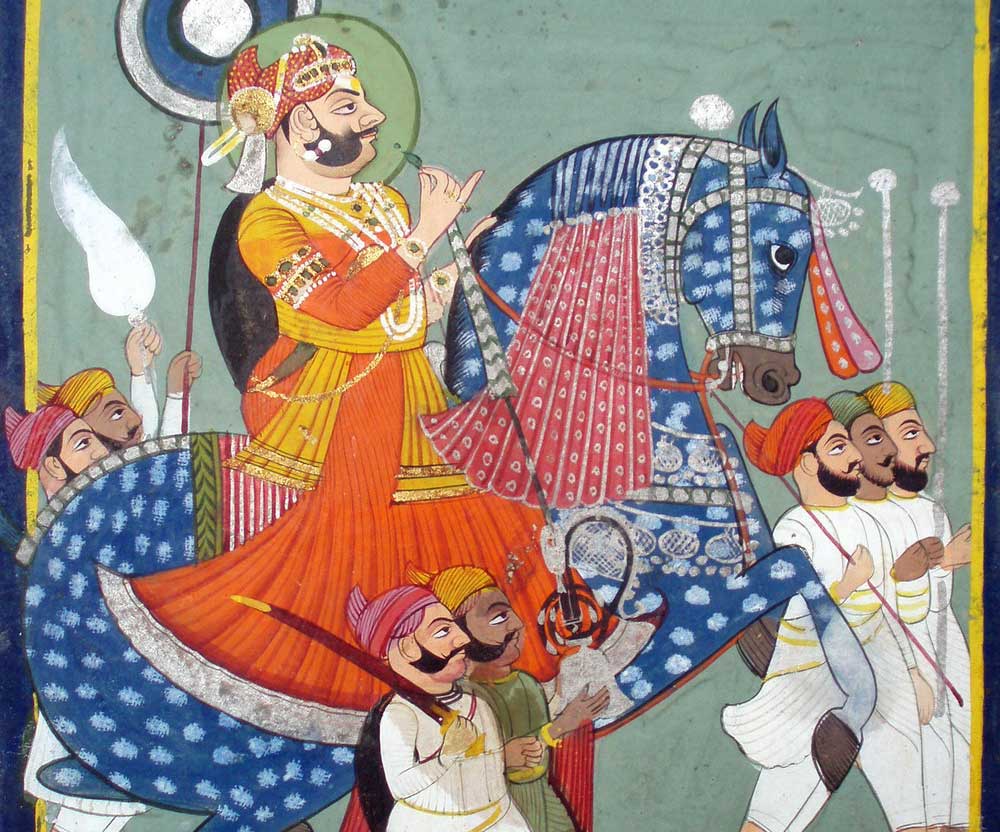 Man Singh |
During his stay in Mewar, Man Singh was invited to a royal dinner. Maharana Pratap refused to join him on the pretext that kings dine only with kings and Man Singh was just a crown prince and that too, of a vassal state of the Mughals. Pratap sent his son Amar Singh for the dinner. Man Singh considered this to be an insult and left. He started advising Akbar to attack and depose Maharana and capture Mewar. Akbar was already looking for a moment like this. He quickly ordered an attack on Maharana.
Akbar himself did not lead the army. He entrusted the task to Syed Hashim of Barrha along with his brothers and Man Singh. There is widespread difference in the opinion of historians as to the strength of the competing armies. Some sources place the army sizes to a ridiculously low strength as of Mewar to just 3000 and Mughals around 10000.
This estimation is highly doubtful going by the stature of commanders of the Mughal army. Man Singh himself was a commander ranking 5000 horse and other ancillaries. Syed Hashim was another commander matching him in stature. Mughal army was also supplemented by the Kachchwaha forces. Rao Lunkaran of Sambhar brought his Rajputs to the Mughal fold too. And the kinsmen of famous Salim Chishti of Fatehpur Sikri were also there present with their followers. This takes the army strength of Mughals beyond 10000 and it is also highly doubtful that Akbar sent only 10000 men to overcome the kingdom which consisted of rough terrain and was his last big obstacle. Mewari records put the number of invading Mughal army to around 80000, which might look exaggerated.
Same sources put Mewari strength to around 20000 comprising of cavalry and Bhils who were the inhabitants of the rough terrain around. Almost all historians agree to the fact that whatever be the number of soldiers, Mewari forces were heavily outnumbered and Mughals were confident of an easy victory owing to this huge difference.
The Mughal army was commandeered by Syed Hashim of Barrha, Man Singh Kachchwaha, Jagannath Kachchwaha, Madho Singh Kachchwaha of Amber, Rao Lunkaran of Sambhar, Gazi Khan of central Asian provinces who was a military adventurer and worked for Akbar, to name a few.
On the other hand, Mewar army was commandeered by Maharana Pratap Singh himself along with his trusted lieutenant Ram Das Rathore, son of famous Jaimal Rathore who laid down his life defending Chittor during the seige. Jaimal was killed by Akbar, not during the actual fighting, but while overseeing the repair work of walls of Chittor by a long-range musket shot.
Apart from these, other commanders of Mewar army were Ram Shah Tanwar of Gwalior who had sought refuge with Mewar after his state was taken over by Mughals. He was aided by his sons, Shaliwahan and two others. Another commander was an Afghan who was a direct descendant of Sher Shah Suri named Hakim Khan Sur. Famous Bhama Shah and his brother Tara Chand were also notable commanders of Mewar Army. Bhim Singh of Dodia had brought his kinsmen to fight alongside Pratap. Worth mentioning here is the name of Rao Punja, the Bhil commander and Jhala Maan who rendered excellent and supreme service to the history of Mewar.
The battle of Haldighati was fought on 18th or 21st (historians are divided on the actual date) June, 1576. It was not a long-drawn battle but a rather short and intensely bloody affair.
Mughal army’s vanguard was led by Jagannath Kachchwaha, Bakshi Ali Asaf Khan and Behlol Khan Pathan. Ahead of this van was a screen of skirmishers belonging to Syed Hashim. Behind the vanguard there was an advance reserve led by Madho Singh Kachchwaha. In the centre was Man Singh. Left flank was led by Gazi Khan and Rao Lunkaran and the Chistis of Sikri. The right wing was personally led by Sayyid Hashim of Barrha along with his brothers and kinsmen. Rearguard was brought up by Mehtar Khan.
Rana Pratap organised his army with himself commanding the centre. The Mewar vanguard was led by Ramdas Rathore along with Bhim Singh of Dodia and Hakim Khan Sur along with his Afghans. The right flank was under Ramshah Tanwar along with his three sons and the famous Bhama Shah and his brother Tara Chand. The left flank was under Jhala Maan or Bida Maan as he is sometimes called.
Rana Pratap was well aware of the numerical superiority of the Mughal army; so, he decided on a full and ferocious attack with speed and hoped to pierce the Mughal lines and thus quickly end the battle.
As soon as the battle of Haldighati started, the screen of Mughal skirmishers was blown away by a ferocious cavalry charge. Without wasting time Mewar right flank of Ramshah Tanwar attacked the left of Mughal army, Gazi Khan and Rao Lunkaran. The Chistis could not face the fury of cavalry charge and ran away from battlefield towards their right. Mughal left flank was decimated to the extent that advance reserves had to be called upon. Jhala Maan on left flank fell upon the Syeds on Mughal right and was pressuring the Mughal lines to break up. Syeds were holding with difficulty.
Advance reserve and vanguard of Mughals had been already pressed into service. Vanguard of Mewar under Ram Das Rathore, Hakim Khan Sur and Bhim Singh clashed head on into the rushing Mughals. After decimating the Mughal left flank, Ramshah Tanwar wheeled to his left to join Pratap in the centre. The Mughal van managed to attack Rana Pratap with Behlol Khan leading the charge.
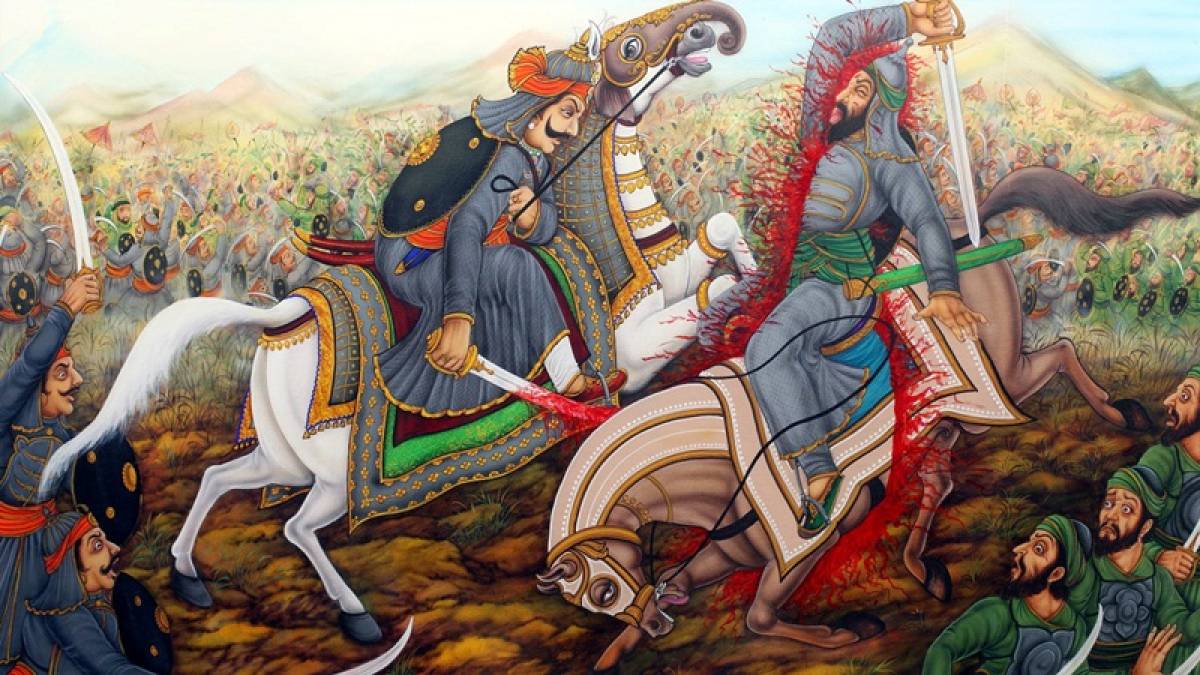 |
Pratap himself came forward to counter him; what happened next froze the blood in the veins of onlookers. Before Behlol Khan could even complete his blow, Pratap seated on his favorite horse Chetak delivered a sword blow on the helmet of Behlol Khan. The blow was struck with such ferocity and precision that Behlol Khan was vertically cut into two pieces along with his helmet, armour and even his horse.
This scene is depicted in many old art works and has been made immortal by bards and poets. Mughal army was petrified and their charge withered. Pratap found the right opportunity to move to the Mughal centre. Bhim Singh of Dodia was ahead of him already cleaving his way into the centre of Mughals. Bhim Singh reached there first and charged Man Singh who was seated on an elephant. In the ensuing tussle, Bhim Singh was killed.
Sensing trouble, the rearguard led by Mehtar Khan came to the fore to aid Man Singh. Meanwhile, Pratap had reached the scene, seeing Man Singh. Pratap attacked him. Chetak was a fearless steed and planted its front legs on the trunk of the elephant. He threw his spear at Man Singh. The mahawat of Man Singh came in between and was pierced. The force of the blow broke even the howda of the elephant. Man Singh was saved due to the sacrifice by his mahawat. This incident rattled him but his dwindling forces were bolstered by the arrival of Mehtar Khan whose soldiers now surrounded Pratap.
Chetak was already wounded by a sword cut on hind leg which was caused by the sword tied to the trunk of Man Singh’s elephant. Rana Pratap was also wounded by now by a musket shot as well as a spear and a sword cut. Ram Shah Tanwar tried to come to aid of Maharana. While trying to reach there, he was killed by Jagannath Kachchwaha in the melee.
Meanwhile, sensing his Maharana in danger, Jhala Maan raced to his help and reaching there, he quickly snatched the royal banner from Pratap which confused the Mughals. They thought of Jhala to be Pratap and fell upon him. Jhala attained his martyrdom fighting meanwhile Pratap retreated from the battlefield.
Pretty quickly Mughals realised their fault and pursued Rana Pratap. Chetak was wounded badly but still took his master to safety. Pratap reached a rivulet which was quite wide for a horse to jump; still Chetak jumped and crossed it but died soon after. There is a cenotaph erected in the memory of this most famous horse of Indian history at the spot.
The Mughals had lost his track. Pratap had a half-brother by name of Shakta or Shakti Singh. He had gone over to Akbar upon coronation of Rana Pratap. Upon seeing the valour and supreme sacrifice of Jhala, he changed his plans and once again joined Rana. He gave his horse to Rana thus helping him escape to safety. Some accounts say that Shakti Singh fought with the pursuers and killed two of them.
Meanwhile, the battle of Haldighati was raging on. Ram Das Rathore was among the last ones to be killed. The heroics of Rajputs of Mewar and the Bhils had stopped Mughal advance but the numbers were dwindling fast for Mewar. The remaining commanders knowing fully well that Pratap had reached to safety organised a well planned and executed retreat.
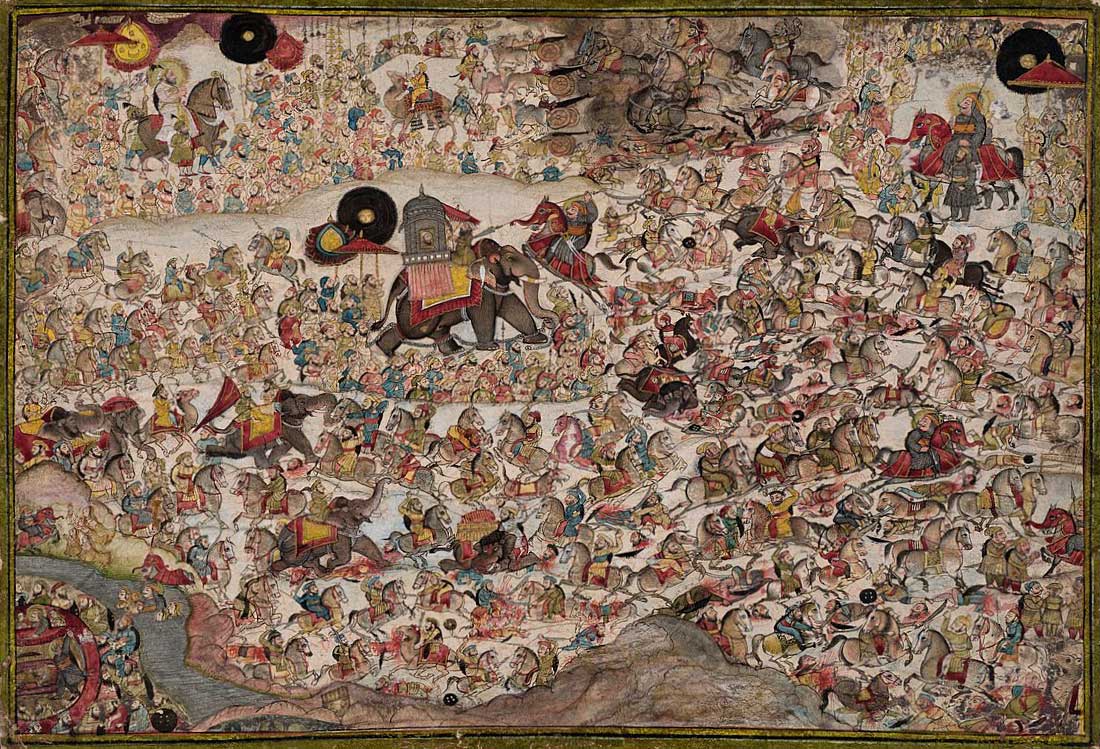 The Battle of Haldighati by Chokha |
The Mughals dared not chase them due to the fear of an ambush. The retreat was so successful that Mewar army took even the baggage and camps with them. Mughals however had captured a prized elephant of Mewar named Ram Prasad. He was later gifted to Akbar, who changed his name to Pir Prasad. The elephant was so loyal to Rana Pratap that he eventually starved himself to death few days later.
This battle might have been the bloodiest of battles in world history. It lasted just 4 hours or thereabout. The carnage was such that the place came to be known as Rakt Talai or the lake of blood. Local sources place the number of dead at around 18000, 4000 from Mewar army and 14000 from Mughal army. It might have been exaggerated but still gives a glimpse into the blood that flowed that eventful day.
The place Rakt Talai is still called by the same name and has a mazaar constructed in honor of Hakim Khan Sur who laid his life in this battle fighting against the Mughals. The cenotaphs of Ram Shah Tanwar and his sons Shaliwahan and two others are also there in Haldighati.
The Mughal army moved next day in pursuit of Maharana who had by now vanished into the hills and reorganised his army. He once again came face to face with Mughal army at Dewair few days after the battle of Haldighati. This time, instead of a full-frontal attack, he followed the strategy of thrust and parry with speedy charges and then retreating. Mughal army was decimated at Dewair and this led to overrunning of Mughal outposts in Mewar by Rana. Within a short span of time, he had taken back whole of Mewar from Mughals except the fortress of Chittor.
Meanwhile, on the Mughal side, Akbar was furious with Man Singh for failing to annihilate Rana. He refused to meet Man Singh for months following the battle of Haldighati.
All these facts point that the battle was in fact a stalemate with both sides not being able to attain their objectives. Superior numerical strength of Mughals could not achieve them their glory as the valour of Mewar army denied them an outright victory.
This battle of Haldighati has been made immortal by many writers, poets and bards in folklore. Haldighati is actually considered something close to a pilgrimage site.
Rana Pratap’s heroics
Mewar chroniclers have left vivid accounts of the exploits of Rana Pratap in battle, to a degree the Mughal chroniclers did not venture to relate, beyond Abu Fazl’s clipped admission that the Rana ‘did valiant deeds’. Nizamuddin Ahmad, another contemporary Mughal chronicler, offers only a brief description of the battle in his Tabaqat-i-Akbari, adding on Rana Kika that “he fought so hard on that day, that he received arrow and spear wounds..” Brijendranath De, the ICS officer who translated Ahmad’s work adds his own footnote to Badayuni’s description inferring that ‘various segments of the Mughal army were defeated and fled’.
Mewar chronicles describe the scenes of Pratap’s valour vividly. In the thick of battle, Pratap ranged striking terror in the imperial ranks all around, ‘thirsting for the luxury of revenge upon his Rajput foe’ as Tod aptly put it. Dodiya Bhim Singh first picked out Mān at a distance atop his elephant and casting caution to the wind, made a wild charge for his elephant, & pausing at a distance, flung his lance at the imperial commander who, swinging to the side, caused it to fly past harmlessly. The bodyguards of Mān Singh and the Mughal Altamsh surrounded Bhim Singh who fought the warriors on all sides in a daring display of bravery before succumbing to overwhelming numbers.
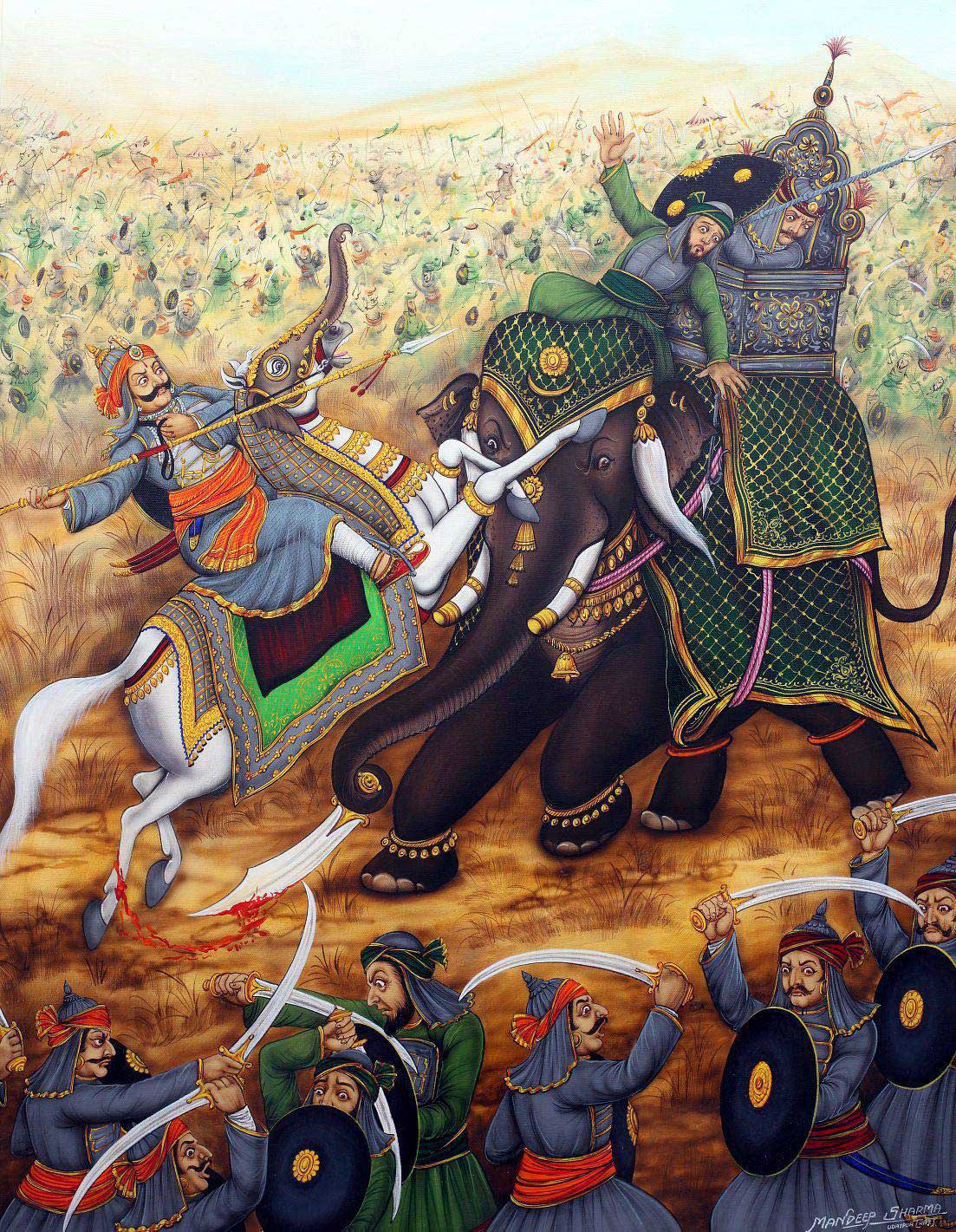 |
Pratap, who had heard the war cry of his Rajput chieftain, then saw the object of his wrath and the subsequent scenes are best described by quoting Kesri Singh at length:
“Toward that thickening throng, impelled by an irresistible urge that filled his heart, the Maharana now wheeled his exhausted and bleeding steed, and with a shout that rang clear above all the awful din of battle, announcing his arrival to Kanwar Mān and daring him to display his prowess at arms, Pratap launched his gallant warhorse into a reckless burst of speed that seemed to carry everything before it. Neither lance nor sword nor the arrows that rained thick as hail around him could stem the course of that intrepid charge. The guards who tried to block his path were swept away and scattered like chaff before a powerful gust of wind; and as the charger closed in upon the tusker, skidding to slow down in a cloud of dust, Chetak reared up against its ponderous bulk so that for a moment his forelegs impinged on the great tusks of the elephant; and from that singular angle, somewhat obscured though his adversary was behind the person of the mahawat, the long-armed Pratap propelled his lance at the Kachhwaha commander of the imperial corps. The shaft passing clean through the body of the driver, who was killed instantaneously, struck a terrific blow on the metal plates of the howda, behind which a thoroughly shaken Mān had dived with alacrity to save himself. The driverless elephant swung around and made off in a wild rush through Mughal ranks, with Mān first recumbent in the howda and later scrambling down his precarious perch on to the driver’s seat to control his fleeing mount,”
adding Pratap had the satisfaction, however short-lived or erroneous of concluding that his lance had, after all, found its mark.
Reading between the lines, we find confirmation of these events in the Mughal chronicles. Abu Fazl concedes Kuar Mān Singh and Rana Pratap approaching each other and doing ‘valiant deeds’, while Badayuni plainly validates the Mewar account thus
“And Mán Singh, springing into the place of the elephant-driver, exhibited such intrepidity as surpasses all imagination.”
The fighters of the Mughal centre including Madhav Singh soon raced to the rescue of their commander, Badayuni mentioning the Rana squaring off against Madhav Singh and ‘a shower of arrows being poured on him’. It is here that the redoubtable Raja Ramshah Tomar ‘repaid the debt of gratitude to Mewar with his life-blood’. Continually shielding the Rana from frontal attacks, and showing ‘extreme obstinacy of resistance’, he earned lavish praise even from the bigoted Badayuni, thus:
“And Rájah Rámsháh of Gwályár, who always kept in front of the Ráná, performed such prodigies of valour against the Rájpúts of Mán Singh, as baffle description”, with Abu Fazl adding “Rajah Rām Shāh with his three sons Sālbahān, Bhān Singh and Pertāb Singh fell, fighting bravely.”
Mewar folklore describes, concurrent to this engagement, Pratap’s famous duel with the burly warrior Bahlol Khan, ending with the heavy sword of Pratap crashing ‘like lightening on to Bahlol’s headpiece cleaving the Mughal vertically and disembowelling his steed as well’.
Present controversy
Today, 445 years after the battle, there is an enduring debate about who actually won the battle.
According to Hooja, both sides claimed victory at the end of the battle. “Mewar claimed they had won because there had been no surrender. The Mughals claimed victory because they still held the field,” she said.
However, Chandra Shekhar Sharma, an associate professor at Meera Girls College in Udaipur noted, “In the light of recent research and evidence, historians have come to the conclusion that Pratap’s army never retreated from the Battle of Haldighati. The war was won by Pratap.”
Sharma based his findings on land records from the 16th century and said that for a year after the 18 June battle in 1576, Maharana Pratap distributed land in villages near Haldighati by handing out land rights inscribed on copper plates that has the signature of the Diwan of Eklingnath.
Back then, he claimed, only the king of a province was allowed to distribute tracts of land, which proves that Maharana Pratap was the winner of the Battle of Haldighati.
References:
pragyata.com - BY PRIYVRAT GADHVI
Saffron Swords: Centuries of Indic Resistance to Invaders - Manoshi Sinha Rawal, Yogaditya Singh Rawal
 Support Us
Support Us
Satyagraha was born from the heart of our land, with an undying aim to unveil the true essence of Bharat. It seeks to illuminate the hidden tales of our valiant freedom fighters and the rich chronicles that haven't yet sung their complete melody in the mainstream.
While platforms like NDTV and 'The Wire' effortlessly garner funds under the banner of safeguarding democracy, we at Satyagraha walk a different path. Our strength and resonance come from you. In this journey to weave a stronger Bharat, every little contribution amplifies our voice. Let's come together, contribute as you can, and champion the true spirit of our nation.
 |  |  |
| ICICI Bank of Satyaagrah | Razorpay Bank of Satyaagrah | PayPal Bank of Satyaagrah - For International Payments |
If all above doesn't work, then try the LINK below:
Please share the article on other platforms
DISCLAIMER: The author is solely responsible for the views expressed in this article. The author carries the responsibility for citing and/or licensing of images utilized within the text. The website also frequently uses non-commercial images for representational purposes only in line with the article. We are not responsible for the authenticity of such images. If some images have a copyright issue, we request the person/entity to contact us at This email address is being protected from spambots. You need JavaScript enabled to view it. and we will take the necessary actions to resolve the issue.
Related Articles
- How Chhatrapati Shivaji Maharaj was establishing Hindu Samrajya by concluding centuries of Islamic oppression - Historian GB Mehandale destroys secular propaganda against Hindu Samrajya Divas
- Dangers of losing our identity: Guru Tegh Bahadur forgotten and Aurangzeb being glorified
- 21-yr-old girl Bina Das shot Bengal Governor in her convocation programme at Calcutta University, got Padma Shri but died in penury
- Kartar Singh Sarabha - The Freedom fighter who was Hanged at the age of 19 and inspired Bhagat Singh
- 26th December to be observed as Veer Baal Diwas to pay gratitude to martyr sons of Guru Gobind Singh: PM Modi
- Savitri Devi broke into tears when Yogi Adityanath decided to leave for Gorakhpur to take vow of sainthood, and today her eyes contain the same tears brimming with pride Yogi has emerged as a Chief Minister of Uttar Pradesh
- Godse's speech and analysis of fanaticism of Gandhi: Hindus should never be angry against Muslims
- 16 year old freedom fighter Shivdevi Tomar, who killed 17 Britishers and wounded many
- Why India’s temples must be freed from government control
- Rana Sanga, the symbol of bravery who defeated Sultan Ibrahim Lodhi and fought Muslim Terrorists for Hindu Existence
- Indonesia: Sukmawati Sukarnoputri, daughter of Indonesia's first president becomes a Hindu leaving Islam
- Hero of Pawankhind: Veer Maratha Bajiprabhu Deshpande, who led 300 Soldiers against 12000 Adilshahi Army defending Shivaji
- Dear NSUI, Bhagat Singh And Subhas Chandra Bose Admired Savarkar And His Ideas
- Freedom struggle of Gurjars against Britishers at Koonja in 1824: 100s of Gurjars Martyred and 100s Hung in Single Tree
- Tirot Singh: An Unsung Hero of the Khasi Tribe who destroyed British with his skill at Guerrilla Warfare




